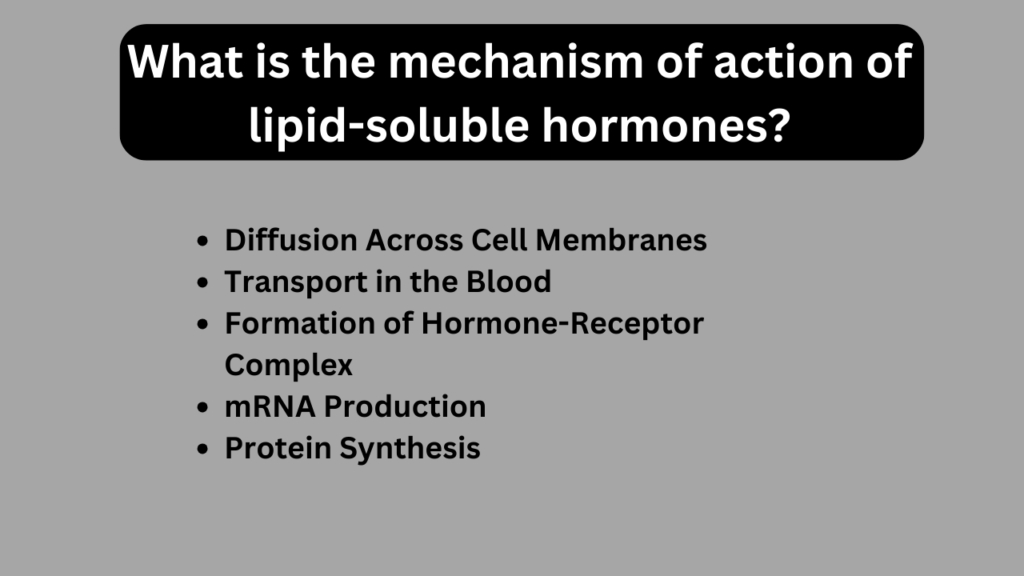Lipid-soluble hormones, also known as hydrophobic hormones or fat-soluble hormones, include hormones like steroid hormones (e.g., cortisol, testosterone, estrogen) and thyroid hormones (thyroxine or T4 and triiodothyronine or T3).

These hormones have a unique mechanism of action compared to water-soluble hormones like insulin or adrenaline.
Here’s the mechanism of action of lipid-soluble hormones:
- Cellular uptake
- Diffusion Across Cell Membranes
- Transport in the Blood
- Binding to Intracellular Receptors
- Formation of Hormone-Receptor Complex
- Regulation of Gene Expression
- mRNA Production
- Protein Synthesis
- Diffusion Across Cell Membranes: Lipid-soluble hormones are composed of molecules that can easily dissolve in and pass through the lipid bilayer of cell membranes. This is because the cell membrane itself is primarily composed of lipids (phospholipid bilayer).
- Transport in the Blood: Lipid-soluble hormones are typically carried in the bloodstream bound to carrier proteins since they are not water-soluble and cannot freely dissolve in the aqueous environment of the blood.
- Cellular Uptake: When a lipid-soluble hormone encounters a target cell, it diffuses through the cell membrane into the cytoplasm of the cell. The hormone does not need a specific receptor on the cell membrane because it can pass through the lipid barrier.
- Binding to Intracellular Receptors: Once inside the cell, lipid-soluble hormones bind to specific intracellular receptors. These receptors are typically located in the cytoplasm or nucleus of the target cell.
- Formation of Hormone-Receptor Complex: When the hormone binds to its intracellular receptor, it induces a conformational change in the receptor protein, forming a hormone-receptor complex.
- Hormone-Receptor Complex Translocation: The hormone-receptor complex can then translocate into the nucleus of the target cell if it’s not already located there. In the nucleus, the complex can influence gene expression.
- Regulation of Gene Expression: Within the nucleus, the hormone-receptor complex interacts with specific DNA sequences known as hormone response elements (HREs) or hormone binding sites. This interaction can either enhance or inhibit the transcription of specific genes.
- mRNA Production: Depending on the hormone and the specific genes involved, the binding of the hormone-receptor complex to HREs can lead to the production of messenger RNA (mRNA) for specific proteins.
- Protein Synthesis: The newly synthesized mRNA leaves the nucleus and enters the cytoplasm, where it directs the synthesis of proteins that mediate the hormone’s effects. These proteins can include enzymes, structural proteins, or other regulatory molecules.
- Physiological Response: The proteins synthesized in response to the hormone ultimately bring about the physiological response associated with that hormone. This response can be relatively slow compared to the rapid effects of water-soluble hormones, as it involves changes in gene expression and protein synthesis.
NOTE: The mechanism of action of lipid-soluble hormones involves their diffusion through the cell membrane, binding to intracellular receptors, regulation of gene expression, and the synthesis of specific proteins that lead to the desired physiological response within the target cell. This process allows for a wide range of long-term and sustained effects on the body’s functions.